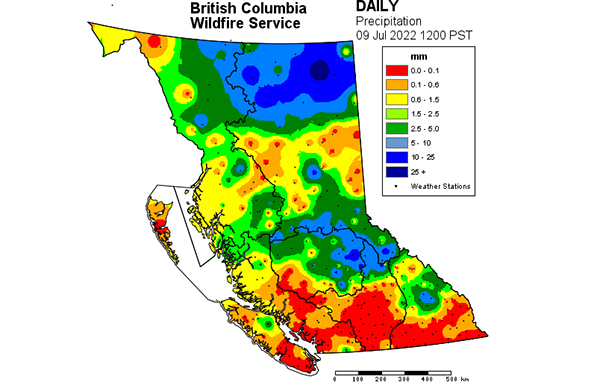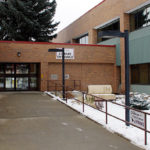Home »

B.C. provides update on outlook for wildfire season
British Columbians can expect a transition to warmer and dryer conditions in July, signalling an increase in overall wildfire risk and fire danger ratings as the season progresses, the Ministry of Forests stated July 7.

As shown in the BC Wildfire Service’s latest seasonal outlook, current wildfire activity is minimal and concentrated in the northern half of the province, where recent rainfall has been minimal. Cool and wet conditions through June in the southern half of the province have tempered overall fire activity.
To help protect British Columbians from wildfires, applications are open for $25 million for community projects that reduce the risk of wildfires. The province is providing the funding to the Forest Enhancement Society of BC (FESBC).
“Last year, we saw just how devastating fire season can be to communities and how critical it is to invest in wildfire prevention,” said Katrine Conroy, Minister of Forests. “Cultural and prescribed burning and forest thinning are proven approaches to reduce wildfire risks. I recently visited Williams Lake and saw firsthand how the Forest Enhancement Society of BC is working with its partners to deliver projects like these and help build more resilient communities.”
The province’s investment in FESBC supports community projects that reduce wildfire risk and enhance wildlife habitat, greenhouse gas reduction, forest recreation and ecological resiliency.
Projects include:
* harvesting and removing beetle- or fire-damaged trees to reduce wildfire risk and rehabilitate the land base;
* thinning trees, removing underbrush, pruning trees and other fuel management techniques; and
* the creation of emergency wildfire escape routes for communities.
FESBC has supported 263 projects throughout B.C., and 43 of these projects have been in partnership with First Nations. These projects have reduced wildfire risk in 120 communities and have created approximately 2,200 jobs.
“Working with local communities to reduce their wildfire risks makes a lot of sense, because they know how to manage their forests to achieve numerous co-benefits to create win-win projects,” said Steve Kozuki, executive director, FESBC. “They are not only protecting their communities, but at the same time with the same funding, they also enhance wildlife habitat, create recreation opportunities, increase ecological resiliency of forests, use the biomass to make green energy, and more.”
The $25 million provided to FESBC is a component of $359 million announced in Budget 2022 to protect British Columbians from wildfires, including $145 million to strengthen the BC Wildfire Service and Emergency Management BC.
This is the largest investment in the history of the wildfire service and is helping to transform the BC Wildfire Service into a year-round service, shifting from its reactive mode to a more proactive approach. It will enable the BC Wildfire Service to focus on all four pillars of wildfire management: prevention and mitigation; preparedness; response; and recovery, the Ministry of Forests noted.
FESBC is a Crown agency established in 2016 to advance the environmental and resource stewardship of the province’s forests by:
* preventing wildfires and mitigating wildfire impacts;
* improving damaged or low-value forests;
* improving wildlife habitat;
* supporting the use of fibre from damaged or low-value forests; and
* treating forests to improve the management of greenhouse gases.
Read more about the July Wildfire Seasonal Outlook.
Lead image: The amount of precipitation has a significant impact on the moisture level in the fuels. Precipitation of 0.5 mm or less tends to be intercepted by the forest canopy preventing it from reaching the fuels on the forest floor.
BC Government map
e-KNOW







